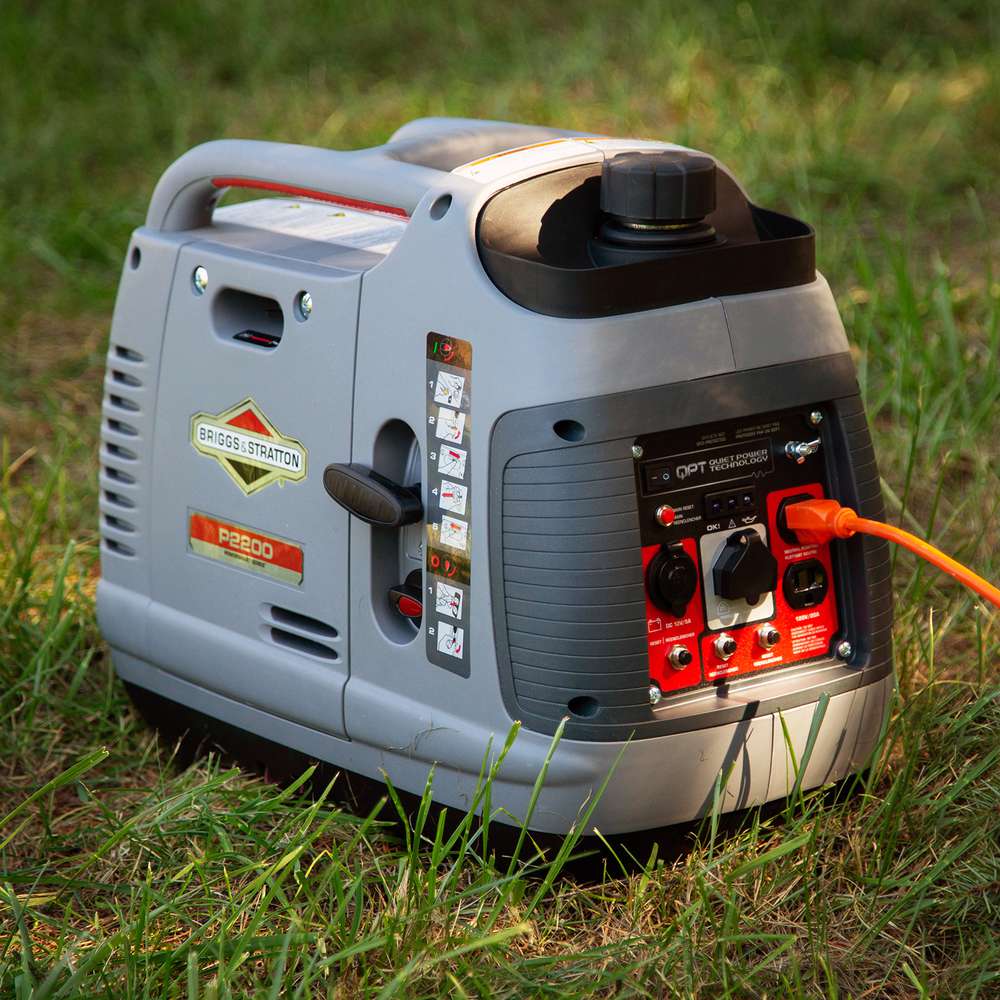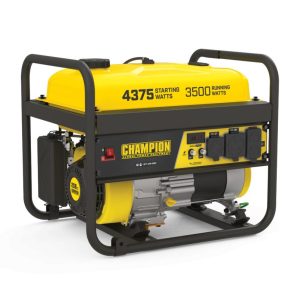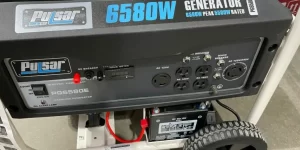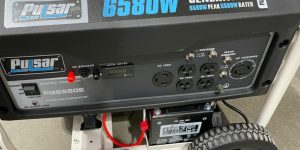16 Briggs & Stratton Generator Starter Issues
In the event of a power outage, most homeowners simply turn to their generators to run the essentials like the refrigerator and sump pump.
You decide to test your generator in anticipation of the next storm, only to discover that it won’t turn on.
Briggs & Stratton generators will not turn on if the air filter is blocked, the choke is set incorrectly, the on/off switch is broken, there is no fuel in the tank, the fuel filter is clogged, the fuel line is clogged, the carburetor is dirty, the spark plug is bad, the spark arrestor is defective, there is not enough oil in the engine, or the fuel cap is broken.
On models with an electric start, you should inspect the battery, starter solenoid, and ignition switch.
Remove the spark plug wire, set the generator on a flat, level surface, and let the engine cool before proceeding with repairs. When in doubt, check the instructions that came with your Briggs & Stratton.

When troubleshooting, repairing, or using a piece of equipment, be sure to first read and follow any safety recommendations found in the manual.If you don’t feel confident in your ability to make the repair or if you lack the necessary expertise or experience, you should get some help from a professional.
Table of Contents
How to Fix a Non-Starting Briggs & Stratton Generator
Gas Tank Empty
A Briggs & Stratton generator fueled by gasoline requires fuel in order to operate. Just in case you didn’t think to check the tank before investigating other potential causes of a starting problem, I thought I’d bring it up.
If you run out of gas, the problem could be a defective fuel gauge or a fuel leak. Fix everything that needs fixing. Refill the gas tank with new gasoline.
Old or Corrupt Fuel
Deterioration of gas quality occurs quickly. It’s possible within the first 30 days of ownership.
If you want to prevent the problems associated with using fuel that is more than 30 days old, you should use new fuel as soon as possible.
Most gasoline contains ethanol, which is a moisture magnet for the fuel system. Because this ethanol and water combination generates a varnish that can limit fuel flow and damage components.
This compound, like the gas, will eventually settle to the bottom of the storage container. It’s incredibly hot in the engine and has a corrosive effect.
Because of the adverse effects ethanol has on a Briggs & Stratton generator, it’s important to keep these things in mind when purchasing, storing, and consuming fuel:
- Get yourself some new fuel with at least a 91 RON (87 octane) grade.
- Never fill up with fuel that has more than 10% ethanol in it. The most ideal fuel has no ethanol at all.
- Within 30 days, all gasoline must be used.
- If you won’t be using the fuel within 30 days, you can keep it from deteriorating by adding a fuel stabilizer to it. (Fuel stabilizer must be added to fresh fuel. The damage done by stale fuel won’t be undone by this.
- Keep gasoline in an authorized fuel container and away from water and flammable materials.
A fuel siphon pump can be used to remove stale gas from your Briggs & Stratton generator. Fuel system cleaning, moisture reduction, and gas stability can all be improved by combining fresh gas with a fuel additive.
Fill up the gas tank with the gasoline. The generator needs to operate for around 15 minutes after it has been started to allow the gas and stabilizer mixture to circulate through the fuel system.
One product that has won my approval is Sea Foam Motor Treatment. Every time I fill up my gas tank, I add this product to mitigate the potential problems associated with ethanol-containing gas. STA-BIL is an other viable choice.
Briggs & Stratton Generator with Blocked Fuel Filter
On some Briggs & Stratton power plants, the fuel is filtered at either the tank or the point of entry into the fuel lines. Fuel sediment bowls and screens are standard equipment on certain other types and must be periodically emptied and cleaned.
To prevent dirt and other impurities from entering the gasoline system and wearing down the engine, a filter or sediment bowl and screen is installed.
If the filter or screen becomes clogged, less fuel will reach the engine.
Briggs & Stratton suggests changing the fuel filter every six months or after 100 hours, whichever comes first.
REMEDY: Either clean the fuel bowl and screen or replace a clogged fuel filter on a Briggs & Stratton.
Briggs & Stratton Generator Fuel Line Clog
The fuel line and other parts of the fuel system might become clogged with the sticky deposits or grit left behind by old fuel. Look for obstructions in the fuel line, which could be preventing enough fuel from reaching the engine.
If you suspect a clog in the fuel line leading to the generator, the solution is to disconnect the line. Compressed air should be blown through the pipe while spraying carburetor cleaning on the clog to help break it up.
If you can’t get the fuel restriction off, a new fuel line will have to do.
Briggs & Stratton Generator with a Filthy Carburetor
When air and fuel are introduced to a cylinder with a spark, an explosion occurs, producing combustion. The carburetor controls the ratio of fuel to air that is sucked into the engine’s cylinders during combustion.
Clogged fuel passages in the carburetor prevent gas from reaching the cylinder, rendering the generator inoperable.
After making sure gas is reaching the carburetor but not the generator, the solution is to take the carburetor out.
Use a carburetor cleaner on it to get rid of the varnish and deposits that have built up inside. Make that the fuel jets, float, and float needle in your carburetor are all clean and in good working order.
A carburetor refurbishment kit or a new carburetor should be used to replace any worn or broken components.
Briggs & Stratton Generator with Blocked Air Filter
Another serviceable component, the air filter, is set up to prevent dust and other particles from entering the system through the ventilation system. Even a little bit of dirt can be harmful to an engine.
If you own a Briggs & Stratton generator, you must always use an air filter. This filter needs to be inspected regularly throughout the year to make sure it is clean and functioning properly.
Each new year, you should replace your air filter. The upkeep process continues after that. The filter needs to be frequently examined and cleaned to keep it in good condition.
An extremely dirty filter can prevent the generator from starting, lead to overheating, and even ruin the engine.
If you have a foam air filter and notice that it has become clogged, you can clean it with some mild detergent and water. Squeeze the filter to remove excess water, then set it aside to dry naturally.
Foam air filters made by Briggs & Stratton can either be used with or without oil; the former type requires a light soaking in clean engine oil to better catch dust and debris. If you are unclear about the specifications for your foam filter, please consult the operator’s manual.
You should get a new air filter if the one you have is tattered, has holes in it, or is a dark hue.
In dusty environments, you should change the paper filter in your generator more frequently than once a year.
Briggs & Stratton Generator Fuel Vent Clogged
The gas cap serves as a vent for the fuel tank. To maintain atmospheric pressure in the fuel tank, a vent must be installed.
If the vent on the gas cap is blocked, the fuel tank will develop a vacuum. Your generator won’t start because fuel can’t get to the carburetor.
The solution is to try starting the generator after loosening or removing the gas cap to let air into the tank and see if that helps.
You may have an issue with the cap if it starts running after you tighten it and let it run for a time, but then stops again. A faulty gas cap should be replaced.
Plugged Briggs & Stratton Generator Spark Arrestor
A metal screen attached to the muffler serves as a spark arrestor, stopping sparks and other hot exhaust particles from escaping. For safety reasons, this screen is mandatory.
If the generator becomes clogged, it will be difficult to start and maintain operation.
The solution is to take out the muffler’s spark arrestor screen. Take a check at it to ensure it isn’t torn and doesn’t have any holes in the screen. If that happens, you’ll need to get a new screen.
If it’s in good shape, you can clean off the soot using a little metal brush. After it has been cleaned, the screen can be reinstalled on the muffler.
Briggs & Stratton Generator Faulty Spark Plug
If a spark plug is dusty, the porcelain is fractured, or the electrodes are pitted, it may not work properly. Because of a lack of spark, your generator will not start.
If the spark plug is otherwise in good shape but slightly filthy, you can clean it to remove the deposits. However, a new spark plug should be installed if its tip is severely discolored or broken.
The spark plug gap should be adjusted in accordance with the owner’s handbook and the manufacturer’s recommendations. An improperly gapped spark plug or a disconnected spark plug wire can prevent the engine from starting.
Briggs & Stratton Generator Ignition Coil Problems
Before checking for a damaged ignition coil, verify sure your spark plug is in good shape. The spark plug needs voltage from the ignition coil in order to ignite.
A non-firing spark plug or faulty ignition coil will prevent the engine from starting.
The problem can be solved by using an ohmmeter to test the ignition coil for continuity. If a break in continuity is detected, the ignition coil must be replaced.
Briggs & Stratton Generator Mistake: Low Engine Oil
Inadequate engine oil prevents a Briggs & Stratton generator from starting. A low-oil-level sensor is included into the generator. If the oil level is low, the engine won’t start.
The generator must be set on a level surface before the oil level can be checked. Take off the oil fill cap and use a dry towel to remove the oil from the dipstick.
Do not tighten the cap on the oil fill tube after reinserting the dipstick. Take the dipstick out and check the oil level. Make sure it’s inside the dipstick’s full range.
If it is not, fix the engine oil level by withdrawing or adding a little oil until it is at the correct level.
If you check the oil level and find it to be where it should be, yet the low oil sensor continues to illuminate, you may have a malfunctioning sensor. The generator should be fixed at an authorized Briggs & Stratton service location.
Failure of the Choke Dial or Switch on a Briggs & Stratton Generator
The OFF-RUN-COLD START dial or switch is found on certain versions of Briggs & Stratton generators. It’s possible that it’s broken and doesn’t work as it should.
If the generator’s choke can’t be adjusted when moving between the choke/start and on positions, the problem lies with the generator’s dial or switch.
The choke on other versions of Briggs & Stratton generators can be adjusted via a lever or knob. To start the engine while it is cold, the choke lever must be moved to the choke position.
If you want to keep your engine going, you’ll need to turn it to the “off” position.
Have a repair shop check to see whether the dial is malfunctioning. If the generator still won’t start after you’ve set the dial or manual choke lever to the correct position, it could be due to a stuck choke plate.
Bad Recoil on a Briggs & Stratton Manual Start Generator
If the starter recoil is worn or broken, starting the generator will be difficult at best. Problems with starting can be caused by a number of factors, including a broken pulley, springs, or clips, or an unstrung rope on the recoil.
Sometimes all that’s required is a new set of recoil strings. On sometimes, you may need to repair or replace components of your recoil. Recoil replacement costs should be estimated before individual pieces are replaced.
It may be more cost-effective to simply replace the recoil assembly rather than dismantle it and try to fix it piece by piece.
Electric-Start Briggs & Stratton Generator Has a Faulty Ignition Switch
A generator’s electric start is only as good as its ignition switch, so if it fails, you’ll be out of luck. If the generator’s electric start fails, you can still get it going by pulling the recoil handle.
The solution is to use a multimeter to check the switch and replace it if necessary.
Briggs & Stratton Electric Start Generator Faulty Battery
Verify that the battery has been charged. You can try charging the battery if it’s low on power. A new battery should be installed if the old one is unable to maintain a charge.
Make sure the cables and wires are connected properly and that there is good continuity between them.
Solution: If the battery voltage is low, charge the battery. If your battery isn’t holding a charge or has died, you should replace it.
Briggs & Stratton Electric Start Generator Faulty Starter Solenoid
Pressing the button on the ignition switch or turning the key (depending on the type) may produce a clicking or humming noise, but the generator still won’t turn on. Alternatively, you may notice that the wire is overheating and even smoking.
These symptoms suggest a faulty solenoid. When the copper plate inside the starter solenoid corrodes or the internal spring weakens, the solenoid stops working properly. The solenoid could have failed due to a poor starter, a dead battery, or an unstable ground.
You can try to power the engine without the starter by connecting the battery cable and starter cable with a screwdriver or pliers.
It could potentially spark, so be careful. Starter solenoid failure is likely if engine can be started without the solenoid.
Before you go and replace the solenoid, make sure there are no stray wires or a poor ground. These are examples of things that could disrupt the solenoid’s normal operation.
It’s good news that most Briggs & Stratton portable generators with an electric start also come equipped with a manual starter recoil for pull-starting. You can limit down the problem to the electric start mechanism if you can manually start it.







